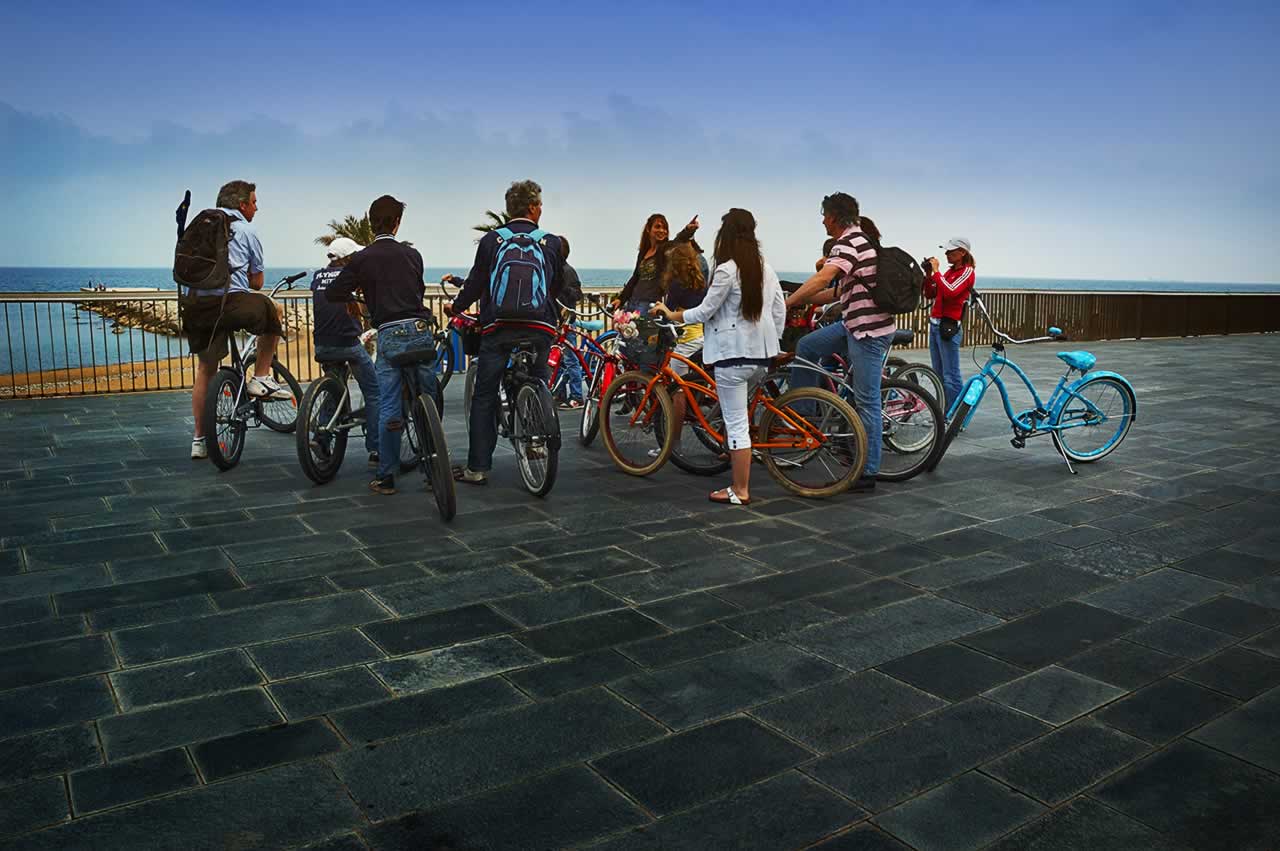
Biking in Barcelona: Take a Tour in the Old City

A different way to sightsee the City Centre of Barcelona: a Bike Tour!
Since roman times Barcelona has grown creating a fascinating mixture of old gothic buildings among upcreasingly modernist ones. Using an expert guide you’ll be able to sail into the changes that built up the city cycling from the barroque Barceloneta till the Gothic Quartier crossing the Ciutadella park, the Ramblas passing next to Columbus Monument, the XIII century Shipyards, the Cathedral, Santa Maria del Mar in the Ribera Quartier.
La Barceloneta
The neighborhood was constructed during the 18th century for the residents of the Ribera neighborhood who had been displaced by the construction of the Ciudadela of Barcelona. The neighborhood is roughly triangular, bordered by the Mediterranean Sea, the Moll d’Espanya of Port Vell, and the El Born neighborhood.
Amongst the attractions on Barceloneta’s beach are German artist Rebecca Horn’s “Homenatge a la Barceloneta” monument, and, where the beach gives way to the Port Olimpic, Frank Gehry’s modern “Peix d’Or” sculpture.
In the center of the neighborhood, there is a small museum, called “Casa de la Barceloneta”, which is housed in a preserved building dating back to 1761.
Gothic Quartier
The Gothic Quarter (Catalan: Barri Gòtic) is the centre of the old city of Barcelona. It stretches from La Rambla to Via Laietana, and from the Mediterranean seafront to Ronda de Sant Pere. It is a part of Ciutat Vella district.
Despite several changes undergone in the 19th and early 20th century, many of the buildings date from Medieval times, some from as far back as the Roman settlement of Barcelona. Remains of the squared Roman Wall can be seen around Tapineria and Sots-Tinent Navarro to the north, Avinguda de la Catedral and Plaça Nova to the west and Carrer de la Palla to the south. El Call, the medieval Jewish quarter, is located within this area too.
The Barri Gòtic retains a labyrinthine street plan, with many small streets opening out into squares. Most of the quarter is closed to regular traffic although open to service vehicles and taxis.
Ciutadella Park
The Parc de la Ciutadella is a park in Ciutat Vella, the old District of Barcelona. After its establishment during the mid-19th century, it was for decades the only green area in the city. It is located at the northeastern edge of the old town, and hosts within its 70 acres (280,000 m2) the city’s substantial zoo (which was home to the famous albino gorilla Snowflake), the Parliament of Catalonia, a lake, some museums, and a fountain of considerable size designed by Josep Fontserè (one of the tutors of the young student Antoni Gaudí’, who worked in his office for some time). It is characterized by being a very busy place, crowded with tourists, and locals, who are usually going for a walk or taking their children to the special section for kids found near the upper margin of the park. This park is optimal for jogging, cycling or boating in the lake.
Ramblas
La Rambla (or Ramblas) is a street in central Barcelona, popular with tourists and locals alike. A tree-lined pedestrian mall, it stretches for 1.2 kilometres (0.75 mi) connecting Plaça de Catalunya in the centre with the Christopher Columbus Monument at Port Vell. La Rambla forms the boundary between the quarters of Barri Gòtic, to the east, and El Raval, to the west.
The Spanish poet Federico García Lorca once said that La Rambla was “the only street in the world which I wish would never end.
Santa Maria del Mar
The first mention of a church of Santa Maria by the sea dates from 998. The construction of the present building was promoted by the canon Bernat Llull, who was appointed Archdean of Santa Maria in 1324. Construction work started in 1329, when the foundation stone was laid by king Alfonso IV of Aragon (III of Catalonia), as commemorated by a tablet in Latin and Catalan on the façade that faces the Fossar de les Moreres. The architects in charge were Berenguer de Montagut (designer of the building) and Ramon Despuig, and during the construction all the guilds of the Ribera quarter were involved. The walls, the side chapels and the façades were finished by 1350. Finally, on 3 November 1383 the last stone was laid and on 15 August 1384 the church was consecrated.
The tour has a duration from 3 to 4 hours and its price would be 20-25€ , including Helmet, Expert Guide and Short Explanations
Companies: http://www.biketoursbarcelona.com or http://www.barcelonabybike.com

